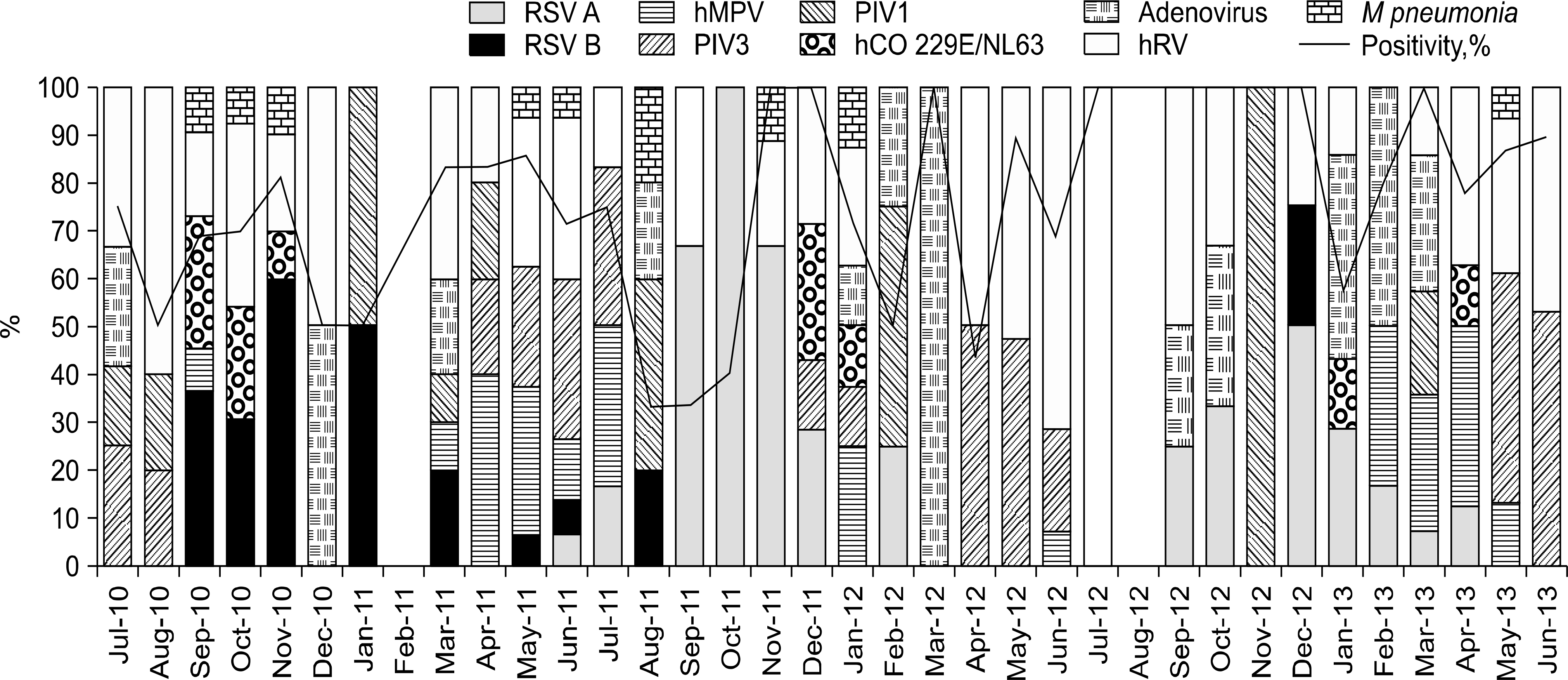초록
Multiplex PCR of nasopharyngeal aspirates detected viruses and atypical bacteria in 75.3% (219/291) of infants with acute respiratory infections from July 2010 to June 2013. Frequent viruses were human rhinovirus (29.9%), parainfluenza virus (21.7%), respiratory syncytial virus (17.9%), and human metapneumovirus (10.3%). Mycoplasma pneumoniae and Bordetella pertussis were detected in 3.4% and 0.3%, respectively. (Ann Clin Microbiol 2014;17:86-90)
Go to : 
REFERENCES
1.Johansson N., Kalin M., Tiveljung-Lindell A., Giske CG., Hedlund J. Etiology of community-acquired pneumonia: increased microb-iological yield with new diagnostic methods. Clin Infect Dis. 2010. 50:202–9.

2.Honkinen M., Lahti E., Österback R., Ruuskanen O., Waris M. Viruses and bacteria in sputum samples of children with community- acquired pneumonia. Clin Microbiol Infect. 2012. 18:300–7.
3.Yoo SJ., Kuak EY., Shin BM. Detection of 12 respiratory viruses with two-set multiplex reverse transcriptase-PCR assay using a dual priming oligonucleotide system. Korean J Lab Med. 2007. 27:420–7.

4.Ham H., Jang J., Choi S., Oh S., Jo S., Choi S, et al. Epidemiological characterization of respiratory viruses detected from acute respiratory patients in Seoul. Ann Clin Microbiol. 2013. 16:188–95.

5.Kim JW., Seo HK., Yoo EG., Park SJ., Yoon SH., Jung HY, et al. Mycoplasma pneumoniae pneumonia in Korean children, from 1979 to 2006-a meta-analysis. Korean J Pediatr. 2009. 52:315–23.
6.Song JH., Oh WS., Kang CI., Chung DR., Peck KR., Ko KS, et al. Asian Network for Surveillance of Resistant Pathogens Study Group. Epidemiology and clinical outcomes of community-acqu-ired pneumonia in adult patients in Asian countries: a prospective study by the Asian network for surveillance of resistant pathogens. Int J Antimicrob Agents. 2008. 31:107–14.
7.Song JH., Thamlikitkul V., Hsueh PR. Clinical and economic burden of community-acquired pneumonia amongst adults in the Asia- Pacific region. Int J Antimicrob Agents. 2011. 38:108–17.
8.Kim YN., Park CH., Kim SH., Yoo SJ., Kim HB. Factors associated with various clinical manifestations of Mycoplasma pneumonia in children. Allergy Asthma Respir Dis. 2013. 1:357–61.
Go to : 
 | Fig. 1.Monthly distributions of frequent viruses and Mycoplasma pneumonia infections in infants with acute respiratory symptoms from July 2010 to June 2013. |
Table 1.
PCR results and monthly distributions for respiratory pathogens in 291 infants with acute respiratory symptoms
| Pathogens | No. of detection | *% | Year 2010 | 2011 | 2012 | 2013 | |||||||||
|---|---|---|---|---|---|---|---|---|---|---|---|---|---|---|---|
| Month | 7-9 | 10-12 | 1-3 | 4-6 | 7-9 | 10-12 | 1-3 | 4-6 | 7-9 | 10-12 | 1-3 | 4-6 | |||
| N | 32 | 41 | 10 | 41 | 20 | 17 | 12 | 45 | 4 | 7 | 19 | 43 | |||
| Positive rate, % | 72.7 | 73.2 | 70.0 | 78.0 | 50.0 | 82.4 | 66.7 | 73.3 | 100 | 100 | 78.9 | 86.0 | |||
| Human rhinovirus | 87 | 29.9% | 9 | 10 | 4 | 11 | 2 | 4 | 2 | 20 | 4 | 2 | 3 | 16 | |
| Parainfluena virus | 63 | 21.7% | |||||||||||||
| Parainfluena virus 3 | 46 | 15.8% | 4 | 10 | 2 | 1 | 1 | 12 | 16 | ||||||
| Parainfluena virus 1 | 15 | 5.2% | 3 | 3 | 1 | 2 | 2 | 1 | 3 | ||||||
| Parainvluena virus 2 | 2 | 0.7% | 3 | 3 | 1 | 2 | 2 | 1 | 3 | ||||||
| Respiratory syncytial virus | 52 | 17.9% | |||||||||||||
| Respiratory syncytial virus B | 28 | 9.6% | 4 | 16 | 4 | 2 | 1 | 1 | |||||||
| Respiratory syncytial virus A | 24 | 8.2% | 1 | 3 | 10 | 1 | 1 | 3 | 4 | 1 | |||||
| Human metapneumovirus | 30 | 10.3% | 1 | 1 | 9 | 2 | 2 | 1 | 6 | 5 | |||||
| Adenovirus | 28 | 9.6% | 5 | 3 | 3 | 1 | 4 | 1 | 1 | 10 | |||||
| Human coronavirus | 16 | 5.5% | |||||||||||||
| Human coronavirus | 13 | 4.5% | 3 | 5 | 2 | 1 | 1 | 1 | |||||||
| 229E/NL63 | |||||||||||||||
| Human coronavirus | 3 | 1.0% | 1 | 2 | |||||||||||
| OC43 | |||||||||||||||
| Human bocavirus† | 14 | 4.8% | - | - | - | - | - | - | - | - | - | - | 1 | 13 | |
| Mycoplasma pneumoniae | 10 | 3.4% | 1 | 3 | 2 | 1 | 1 | 1 | 1 | ||||||
| Influenza virus A | 6 | 2.1% | 1 | 3 | 1 | 1 | |||||||||
| Human enterovirus† | 3 | 1.0% | - | - | - | - | - | - | - | - | - | - | 3 | ||




 PDF
PDF ePub
ePub Citation
Citation Print
Print


 XML Download
XML Download